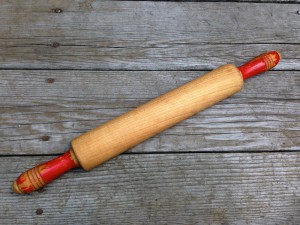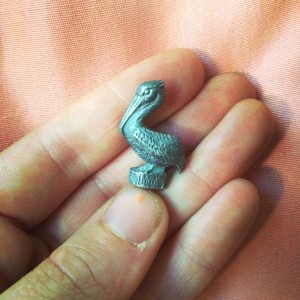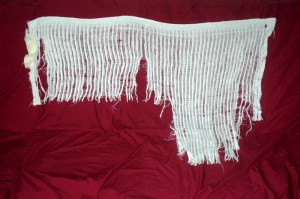
Maybe it’s a stuffed elephant. Could be a pepper shaker. Or perhaps a very special rock.
Many adults have an object that’s particularly dear to them, but it’s not something that most people openly talk about. Unless you ask them.
Share your special thing with us on Facebook
Emily Walsh has always collected trinkets, from coins to keys to board game pieces. When she was a little girl, she carried her special things around in a bag.
When she got to be an adult, she didn’t grow out of this love for special objects. When she traveled, she always carried a little star her sister made for her.
On a backpacking trip to the Himalayas, she started asking the other hikers she met if they were carrying anything special.
She heard many responses: pictures, good luck charms, special rocks.
“It just seemed to be a really widespread phenomenon,” Walsh says. “It is the most interesting to me when you are carrying these things on your back. It really is telling about how important they are to you.”
When Walsh went on to pursue a master’s degree in social work, she read the work of a prominent 20th century British psychiatrist named Donald Winnicott. He said it was natural for kids to get attached to special things, which he called “transitional objects.”
But Winnicott said that adults are supposed to grow out of those things.
That flew in the face of the stories that Walsh had been hearing for years. She just couldn’t see all of the people she’d been talking to as pathological. So she decided to write a thesis about it.
Walsh asked about 30 adults if she could interview them about a special object in their lives. She defines “special object” as something with “vital meaning.” Something that people don’t want to live without.
In fact, she asked people what it would be like to not have their object.
“People would get silent,” she says. “Or just be like, ‘I don’t want to think about that.’”
The objects people talked about about were varied. They included everything from a table, to a train ball bearing, to a framed copy of the first chapter of the Koran.
The special things that people told Walsh about fit roughly into three categories: charms, mementos and objects with exceptional physical characteristics.
There are many powerful feelings tied to these objects, but they aren’t all positive. Some people told Walsh that their special object can be a burden.
“One of my participants had a bicycle from his father,” she says, “and he was sort of like, ‘Why do I have such a huge heirloom?’ He said as well as being a wonderful reminder of his dad, this is a lot to have to carry around.”
Even people when people consider their object a heavy weight, though, Walsh said they flinch at the idea of getting rid of it.
“If you inherited it, there’s the disrespect to whoever wanted you to have it,” Walsh says. “So maybe you don’t even like this thing, but you can’t give it away because of that relationship.”
Then there are other people, Walsh said, who worry that the thing itself will feel bad if they give it away.
“Someone talked about a stuffed lobster,” Walsh said. “She just felt like, ‘I can’t give this away, because it’ll hurt the thing’s feelings.’”
When Walsh’s interview was over, an odd thing happened at the recording studio. The engineer, Bart Rankin, came out of the sound booth to talk with her.
“I was touched by the interview,” Rankin remembers. “So I walked into the studio and I showed her a special object of my own.”

Bart Rankin showed Mr. Giraffe to Emily Walsh after hearing her talk about adults and their special objects. (Photo: Bart Rankin)
Rankin’s object is a stuffed giraffe that his wife gave him when they first got together.
“It’s part of our relationship, so between the two of us we’ve built up a mythology around Mr. Giraffe,” Rankin says.
Most days Rankin takes Mr. Giraffe with him to work in his bag, but they’ve also seen the world together.
“He’s actually driven on the wrong side of the road in Ireland,” Rankin says. “And you know, most stuffed giraffes have not.”
Until Emily Walsh came into the studio, Rankin hadn’t told anyone outside of the family about Mr. Giraffe. He thought they might think it was silly.
“Of course, I would tend to agree with them that it’s silly,” he says. “As a grown man who’s nearly 50, it’s sort of funny to have a stuffed animal that’s sort of your special friend.”
Rankin thought about it, though, and decided to go public with Mr. Giraffe anyway.
“I suppose if anyone did not want to be my friend, then maybe they’re someone I don’t want to be friends with anyway,” he says, “if they take a stuffed animal that seriously.”
Rankin has always been a collector. He keeps ticket stubs from concerts and programs from events. But before Mr. Giraffe, he hadn’t had one special object since he was a kid.
That’s one place where he and his wife differ. He says she isn’t a collector, but she does hang onto one special thing.
“She has a little, I think at this point, a piece of a blanket that was hers when she was a little kid,” Rankin says. “She hangs onto that and often sleeps with it. “
Many of the people Emily Walsh talked with actually named baby blankets and childhood stuffed toys as their special objects.
One of those people is Walsh’s friend Sophia Slote. Her “Blankie” is the one she was wrapped in as a baby.
“He was originally a rather normal-sized baby blanket,” she says. “Blue on one side, pink on the other.”
Now Blankie has been through a lot, and he looks a little different.
“He’s just a very small—you can hold him easily in both hands—ball of yarn,” she says.
Slote thinks one reason she got so attached to Blankie is that when she was a kid, she split her time between her parents’ homes.
“Blankie was in some ways the most static thing in my life,” she said. “Part of his purpose is to sort of fill the absence that my parents couldn’t really fill at that time.”
Blankie has already seen a lot of wear and tear, and Slote said it’s painful to think about the possibility of wearing him out.
“I will make some big changes so he lasts, I think,” she said. “It’s tricky, though, because in order to get soothing from him, I’m destroying him.”
This next part might be a little hard to believe, but it’s absolutely true. Slote was in the same studio as Emily Walsh, on a different day. A different recording engineer was working, but the exact same thing happened.
At the end of the interview, the engineer came in to tell Slote about her own special object. The engineer’s name was Cara Foster, and her object was—that’s right, a baby blanket.
Foster says the blanket stayed on her bed until she was 23, and she’s just never felt like throwing it away.
“It was always around, until I moved in with my future husband and started sharing a bed and it just kept ending up on the floor,” she says. “I wasn’t cuddling the blanket anymore for comfort; I had somebody else, and it was replaced. But I never pitched it.”
These days, Foster’s blanket is in one of her dresser drawers. It’s in a Ziploc bag with a sweatshirt, a stuffed animal, and a piece of a quilt from her childhood home.
She doesn’t take these things out very often. She just wants to know they’re there.
“I think we all have heirlooms,” says clinical psychologist Susan Pollak. “We all have objects, furniture, jewelry, that have incredible meaning.”
Pollak teaches at Cambridge Health Alliance, part of Harvard Medical School. She said she believes it’s fine, even good, for adults to have special objects. Pollak has heard many stories from adults who have drawn tremendous comfort from beloved objects.
“One of the fascinating things about being a therapist is people tell you things that they wouldn’t tell anyone else because of a sense of shame, or a sense that it’s not quite grown-up to talk about the fact that you’ll bring out your teddy bear or a piece of your blanket when you’re going through hard times,” she said.

Using her grandmother’s rolling pin transports Susan Pollak back to Grandma Tilly’s kitchen. (Photo: Susan Pollak)
Pollak says, though, that she doesn’t think it’s immature at all. In fact, she thinks it’s universal.
“I think we all need some comfort,” Pollak says. “It’s just that we don’t readily share how vulnerable we are.”
Susan Pollak has a special object of her own. It’s a 1930s rolling pin that she inherited years ago from her Grandma Tilly.
“I would use the rolling pin and talk to my daughter and my son about Tilly,” she says. “Then I began to think about how powerful this rolling pin was for me and how in many ways she still seemed to be alive in my kitchen.”
When you start asking, it really does seem like nearly everyone has a special object. That’s certainly what Emily Walsh found. When she was contacting people for her research project, most people told her right away that they had one.
There were only four men who said they didn’t have anything like that.
Then, she called them back a couple of days later.
Walsh said all four responses went something like this: “Oh, yeah, there’s this thing and I can talk for an hour and a half about it because it has that much meaning for me.”
Subscribe the to the TRBQ podcast on iTunes.
Listen to the TRBQ podcast on Stitcher.
Follow TRBQ on SoundCloud.







Loved both the idea of this and how it played out, Emily. I hope you will continue to consider the importance/meaning of transitional objects throughout your career and life. What a wonderful topic for your thesis!
–Uncle Joe